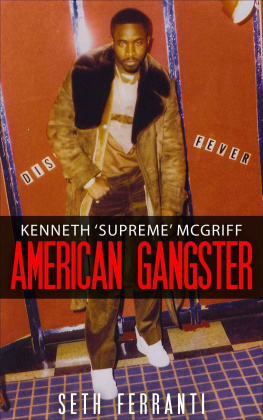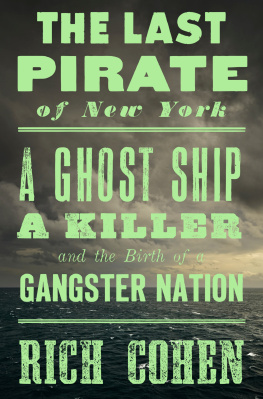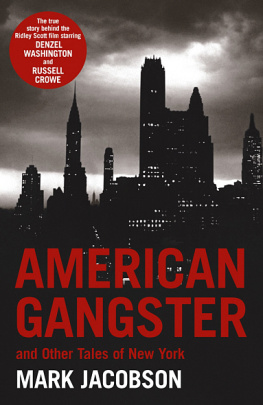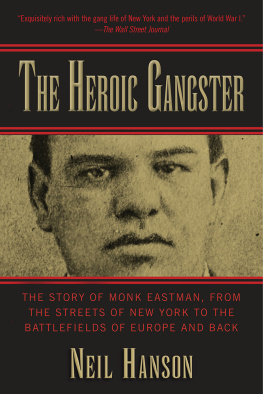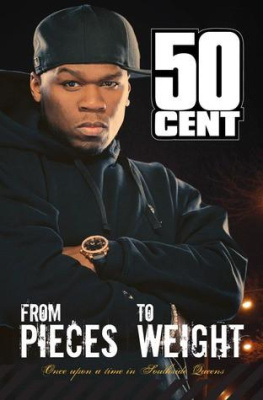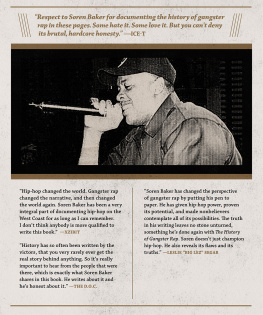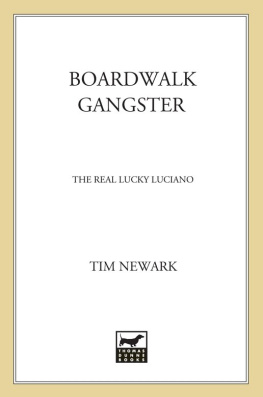Kenneth Supreme McGriff
Seth Ferranti
Table of Contents
Kenneth Supreme McGriff
Supreme is a towering street legend immortalized in both hip-hop and hood lore. An infamous drug lord with ties to both major players in the rap industry and a notoriously profitable and ruthless drug crew, The Supreme Team, that ruled the same Queens streets that later produced platinum selling artists like Ja Rule and 50 Cent. To both law enforcement and a generation of rappers and hustlers, Supreme is a black John Gotti, a larger than life figure whose underworld reach seemed limitless. He was the only one of the renowned drug kingpins of the 80s to outlast the crack epidemic and law enforcements pounding. But the feds finally got their man and Queens Reigns Supreme author Ethan Brown probably said it best, By taking the storm and not flipping Preme secured his spot as one of the baddest guys ever to walk the streets of NYC.
Part 1- The Jump Off
Kenneth McGriff was born on September 19, 1960 in the southside of Jamaica, Queens. He lived right across the street from the Baisley Projects, says Tuck, a former Supreme Team member and Queens native. His pops was ex military, a strict disciplinarian. Preme grew up on Foch Boulevard and the Guy Brewer intersection in South Jamaica. An unremarkable area in the five boroughs of New York City at the time but an area that would go on to spawn some of the biggest crack lords in the citys drug lore.
The brother Supreme grew up in the 60s and the 70s when guys in the life had a semblance of the principles, says T, a D.C. convict who befriended Supreme in prison. He stays true to his word and always has. His whole family is square. All his brothers and sisters are professional people in their own lives. The future kingpins beginnings were humble. He was raised in a blue-collar environment.
The working class neighborhoods of South Jamaica, St. Albans and Hollis where Supreme grew up lie in the 103rd precinct which is a 4.8 square mile imperfect box encompassing Van Wyck Expressway to the west, Hillside Avenue to the north, Francis Lewis Boulevard to the east and a jagged line that runs along the 110th Avenue to the south. Around 125,000 people live within its borders, 62 percent of them black. For all intents and purposes Supreme had a regular inner city childhood, coming of age in a two parent household. He didnt grow up in the projects but they were right next door. Both his parents were transit workers on New Yorks subway system. They worked hard to provide a better life for their children, who all attended school in New York Citys public school system. Supreme was a talented student and an avid football player who was preparing for college, like any other ordinary kid coming of age in the 1970s.
But Supremes future would be anything but ordinary.

His life was significantly altered when he discovered a new philosophy dictated by five percenter ideology. God-Be and his brother recruited and organized us within the five percenter nation. Gerald Prince Miller, Supremes nephew and future partner in crime said about their induction into the culture. He been in that since he was 10, T says. The five percenters are a splinter group that broke away from the Nation of Islam in 1964 under Clarence l3X who was part of Mosque #7 under Malcolm X. Clarence 13X rejected the belief that NOI founder Wallace Fard was god. The five percent doctrine teaches that the black man is god and their women are earths. They believe that they are the chosen five percent of humanity, hence the name. They drop jewels and science, speak in cyphers and contend that 85 percent of the population lack knowledge and that 10 percent are devils, leaving the chosen five percent, which they claim.
Supreme got his name in 1971 from his affiliation with the five percent nation, Lance Fuertado, another infamous Queens gangster said. The fiery teachings came slamming off the radio and boomboxes in the late 60s. It was hip-hop before hip-hop. The messages were delivered as a staccato street rap that mesmerized NY City youth and gave a name and a way of life to the young Kenneth McGriff who doesnt smoke, drink or eat red meat, Tuck says in accordance with his beliefs. You have a given name according to your characteristics. T says. Supreme is his given name. And in five percenter doctrine, Supreme means the most high. But the five percenter affiliation led Preme to other vocations that would drastically affect his life. What probably influenced him into the game was becoming a five percenter. T says.
With most of them coming out of prison it had to influence his decisions. T concludes. The prison system was an important recruiting ground for the five percenter message and they actively recruited prisoners and ex-cons into their ranks. Five percenter imagery and lyrics have also taken their place in hip-hop. Rappers like Busta Rhymes, Wu-Tang Clan, Rakim, Nas and A Tribe Called Quest have all proscribed to the teachings and spread the message in their music and songs. It really started with the five percenters, Preme and them were god bodies. Thats like 1980. They wasnt selling drugs at that time. It was a religious thing. Bing, another Supreme Team member and hustler from the era says. Peace God, was how five percenters greeted each other, earning Premes crew that hung on Linden Boulevard the name Peace Gods. And out of all the Peace Gods, Supreme was the most promising. He was turning into a young proficient hustler with a whole crew behind him. His whole crew were five percenters, T says and they would play a vicious part in the coming crack era that would engulf Queens and make headlines in New Yorks tabloid newspapers.
The role models for the young crew were guys on the street from the hood. The hustlers, the drug dealers, the players, the pimps, the stick-up kids and strong arm robbery specialists. By studying these guys Supreme picked up a lot. He started carrying himself like an older, more established hustler, emulating the guys he saw holding it down on the block. He studied the ghetto stars of his hood like Ronnie Bumps Bassett and acquired the swagger of a man on the hustle. Behind Supremes two thousand dollar suits and crisp white shirts was a seriousness about hustling that made the youngster stand above his peers on the street, and the older dudes noticed and took Supreme under their wings. His charismatic smile, piercing green eyes, muscled physique and good looks gave him an image that certified him a hood star even before his time. As a youngster Supreme was becoming a larger than life figure and with his crew growing and backing him up with a fierceness born of the hood, rivals were aware that crossing Preme invited an attack from the much feared team, giving Preme Don Dada status in the streets of Southeast Queens. Preme created an underground economy for us to thrive and flourish. Prince said. And as a young man Supreme transformed a group of local guys into a lucrative and brutal drug gang that served a legion of crack addicts in and around Baisley Projects. But first came Seven Crowns.
Part 2- Learning the Game
In Queens, the conflicting streets of private homes and grim city housing projects gave birth to another factor that proved pivotal in the young Supremes life- The Seven Crowns. Seven Crowns was a seventies thing, Bing says. I was in Seven Crowns at the end. It was all on the southside, but different areas. It was all one gang. Everybody was in one gang before they started selling drugs. They had little gang fights but no major killings, little brawls, shit like that, regular shit, no gunplay. We came together against outsiders.

Next page
